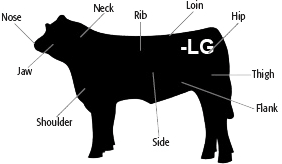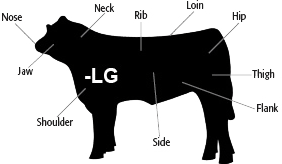Frequently Asked Brand Questions
Your brand is your proof of ownership and the best way to identify your livestock.
- Law enforcement criminal investigations use brands on a local, state, and federal level;
- Texas Animal Health Commission and USDA-APHIS trace back for animal disease;
- Agricultural lending institutions use brands to secure livestock loans;
- County sheriff offices determine ownership of estray livestock;
- Judges and attorneys reference brands in many types of civil litigations involving livestock; and
- County clerks often receive a subpoena to testify in court as to the accuracy of their brand registration procedure.
The County Clerk’s office in the county or counties you are running livestock.
Brands are registered in Texas by the county clerk of the county in which you run livestock. The brand must be registered by the county clerk for the brand to be considered a legal means of ownership.
In Oklahoma, the Oklahoma Cattlemen’s Association is responsible for brand registration.
Texas brand registration is good for a 10-year period. The new period starts on Feb. 28, 2022, and goes through Aug. 30, 2031. At that time all brands must be re-registered.
Yes. In Texas brands must be re-registered every 10 years.
Brand re-registration always begins in the year ending with a 1. For example, the next brand re-registration period begins Aug. 31, 2021, and closes Feb. 28, 2022.
If you do not re-register within that period, then your brand is up for grabs by someone else. Brands must be re-registered within that period regardless of the date it was originally registered. –Section 144.04 Texas Agriculture Code
In Oklahoma brands are re-registered every 5 years and is the responsibility of the State Board of Agriculture (Title 2-4-7 of the Oklahoma Agriculture Code). While brand re-registration dates are not specified, the code explains that the owners of currently registered brands will be notified about the re-registration period.
Yes, all brands must be re-registered regardless of original registration date.
No.
Yes, after six months the brand is available to anyone.
Cost may vary by county. The county clerk office may charge the same fee for brand transfers as for registering a new brand.
CLICK HERE Find your county clerk office online.
The county clerk office is the only place that has archived files.
The county clerk office can give you that information.
Yes, it is lawful for any owner to have, own and use more than one brand and/or mark.
No. Use one form for each brand you wish to register.
The brand location is as important as the brand itself. The same brand may be registered in the same county as long as the location on the animal is different. Shown below, these are considered two distinct markings:


Yes, the same brand design can be registered in the same county by different individuals as long and the location of the brand is different.
Yes, in other counties. Your brand registration is good only in the county or counties where you register it.
Yes.
Brands may be transferred. This requires a notarized affidavit signed by the current brand holder that relinquishes title of the brand to the transferee. Brand transfers must be sent to TSCRA
The heir must provide proof of will or family agreement along with death certificate.
Yes. A parent or legal guardian can sign for the child. The proper use of a brand is the parent/guardian’s responsibility.
If the horse came from Texas, you would need to know in which county the owner registered the brand. The county clerk’s office has the current and the archived brand registration files. There is no statewide registry in Texas.
According to Chapter 142 of the Texas Agriculture Code,
“If an estray, without being herded with other livestock, roams about the property of a person without that person’s permission or roams about public property, the owner of the private property or the custodian of the public property, as applicable, shall, as soon as reasonably possible, report the presence of the estray to the sheriff of the county in which the estray is discovered.”
Please assist the sheriff by providing the location, number and description of the estray livestock.
You should register your brand in the Texas county in which you will be grazing the cattle. Check with the Texas Animal Health Commission for permits needed to enter the state.
Yes, this is considered a misdemeanor.
No, it is illegal to brand an animal unless the brand has first been properly registered.
See the Texas Agriculture Code CHAPTER 144. MARKS AND BRANDS or read the relevant section here:
- Section 144.041 of the Texas Agriculture Code addresses recording of marks and brands:
- § 144.041. MARKS AND BRANDS TO BE RECORDED. (a) Each person who owns cattle, hogs, sheep, or goats shall record that person’s earmarks, brands, tattoos, and electronic devices with the county clerk of the county in which the animals are located.
- (b) A person who owns a horse shall record an identification mark authorized by Section 144.001(b) with the county clerk of the county in which the animal is located.
- (c) The county clerk shall keep a record of the marks and brands of each person who applies to the clerk for that purpose.
- (d) A person may record that person’s marks and brands in as many counties as necessary.
- (e) A person may record any mark or brand that the person desires to use if no other person has recorded the mark or brand, without regard to whether that person has previously recorded a mark or brand.
- (f) Not later than the 30th day after the date a county clerk receives a record relating to cattle or horses under this section, the clerk shall forward a copy of the record to the association authorized to inspect livestock under 7 U.S.C. Section 217a (Texas and Southwestern Cattle Raisers Association).
TSCRA traces its beginning to 1877, when a group of ranchers formed an association to combat livestock theft. As the largest and oldest livestock association in Texas, TSCRA represents more than 15,000 beef cattle producers, ranching families and businesses who manage approximately four million head of cattle on more than 51 million acres of range and pastureland, primarily in Texas and Oklahoma. TSCRA provides law enforcement and livestock inspection services, legislative and regulatory advocacy, industry news and information, insurance services and educational opportunities for its members and the industry.
The commissioned peace officers who serve as the TSCRA special rangers investigate thousands of agricultural crime cases each year and recover an average of $5 million in stolen cattle and assets for ranchers each year.
TSCRA special rangers are commissioned through the Texas Department of Public Safety or the Oklahoma State Bureau of Investigation. Those special rangers stationed along the Texas/Oklahoma border are dually commissioned to investigate agricultural crime in both states.
TSCRA special rangers are stationed in districts in Texas and Oklahoma where they:
- investigate thefts of cattle, horses, saddles, trailers, equipment, and even poaching
- pursue white-collar criminals who commit agricultural fraud
- inspect livestock to determine ownership and prevent theft after a natural disaster such as wildfire, flood or hurricane
- determine the ownership of estray, or stray, livestock
- educate landowners on how to prevent theft and spoil the plans of thieves
- keep the peace
